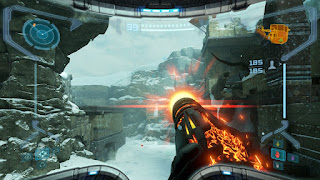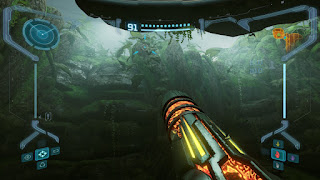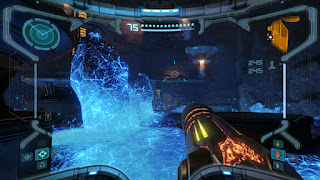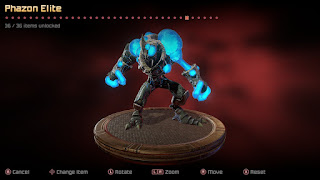The last Nintendo Direct shadowdropped Metroid Prime Remastered on us, where at first it was only available on the eShop, but by now the physical version got released worldwide as well. It brings back the GameCube and Wii classic with an amazing graphical update and some new control options, all while being offered for a lower price point, which is quite unusual for Nintendo.
The remaster also marks the return of Retro Studios, who haven't put anything on the Nintendo Switch so far, except for Donkey Kong Country: Tropical Freeze back in 2018. But around ten other companies have assisted them in this, where it's likely that the torch will be passed to create remasters of the two sequels, while Retro works on Metroid Prime 4.
Looking at the remaster makes you question why Retro Studios didn't get
tasked with working on the fourth game right away, because they
demonstrate here that they clearly have it in them. Maybe the producer, Kensuke Tanabe, wanted to work with someone closer to home, but playing Metroid Prime Remastered will assure everyone that Metroid Prime 4 is in the right hands and should have never been outsourced to begin with.
Graphics & Sound
Metroid Prime Remastered is without a doubt one of the prettiest games that Nintendo has released and certainly offers some of the best graphics for a Nintendo Switch game with a realistic art style. It's amazing what Retro Studios has managed to pull off, where everything runs in fluid 60FPS and looks absolutely stunning.
It's technically still a "remaster", as the title indicates, where the game seemingly got ported into a newer version of RUDE, their inhouse engine. The game still mostly plays and behaves exactly like it did in the original, where you can even replicate some glitches, like the rapid fire missiles. But all of the models and textures got redone with great attention to detail and the visuals overall profit from modern lighting effects, where it looks more like a remake. It's similar to Ocarina of Time 3D in that regard, but a lot more impressive.
This goes beyond the "it looks as good as you remember it" approach, even though it's all quite faithful, because the level of detail is on a whole other level. There is no overstating of how good this looks for a Nintendo Switch title and it puts all the HD remasters that we have seen from Nintendo so far, like Twilight Princess HD, to shame.
When was the last time in a (Nintendo) game where you've just stopped to marvel at the details? To look at a corner and fancy how nice everything looks? Well, Metroid Prime Remastered will certainly make you do this, even if it's just for a bit.
Not everything looks equally amazing, of course, where some parts are as bland as you remember them, especially inside the different Space Pirate facilities, but that's not necessarily the fault of the remaster, but the source material. They did make some environments pop more than others, though, where the lighting is just very vibrant now in some places, but not so much in others.
There are some visual flaws with the remaster, however, for example how blurry everything looks now with the Thermal Visor. The visors weren't much fun to use in Metroid Prime to begin with, so they didn't have to make them even harder on the eyes... And if you want to just light the way with your beams, like you could before, then this won't be possible any longer, because the dynamic lighting has been toned down significantly.
It's the same with some particle effects, like the snow in Phendrana, but at least this seems deliberate to distract less from the new environmental details. Even the stronger glow of the doors simply adds to the overall aesthetics, so it's not like all changes are bad per default.
On the sound department there wasn't much to improve, because the original is still holding up very well here, but it's noticeable how the sounds may change now depending on the environment. Firing in one of the many tunnels sounds a lot more like you're in an enclosed space, for example, where this has a nice touch to it.
Controls
The remaster offers four different control schemes with a variety of options attached to each one of them, like precise sensitivity settings or inverting the different axis for different use cases, which is really good and not always a given with Nintendo games. The classic and pointer controls return from the GameCube and Wii versions respectively, but there are also the new hybrid and dual stick controls. The former lets you use motion aiming via the press of a button, while the latter plays more like any traditional first person shooter with a gamepad, but you can also add gyro aiming on top for better precision.
None of these control schemes seem fully ideal, however. Well, there is nothing wrong with the classic controls if you want to play the game exactly as on the GameCube, but the lack of gyro aiming makes it the most limited out of the four control schemes. It's also the only setup without the Spring Ball, where you will simply make things harder for yourself, but you will be playing the game as originally intended.
The hybrid controls are a good compromise when you want the classic experience, but still be able to adjust your shots and don't want to be locked in place whenever you need to aim manually. It might be bit awkward to use, however, depending on the player.
The dual stick controls do a much better job of mixing gyro and stick aiming, where they feel quite good at first, but since you can't use the right analog stick to switch between beams, it comes with an overloaded layout. Now you need to switch both the visors and the beams via the D-pad, but for the beams you have to hold the X-button (which can be swapped with firing Missiles on R).
In tense combat situations, where you potentially have to dodge enemy fire and switch weapons at the same time, you won't be able to perform it all at once with these controls and might find yourself overwhelmed by them. Switching beams and visors via motion control gestures, like in the Wii version, is sadly not an option any longer. It wasn't ideal either, but at least for this particular control scheme it could have helped.
Speaking of the Wii version, if you're happy with using Joy-Cons, you should give the pointer controls a try, because they probably work the best out of the four control schemes, unless you want to to stick to a Pro Controller. They even have an edge over the Wii controls, because you don't need the aforementioned motion gestures to switch beams and visors any longer, since there are enough buttons on the Joy-Cons for everything now. Quickly switching beams with the right stick, while moving and aiming all at the same time, just feels very powerful, so this should be the recommended way to play the game.
However, both the ZR and R buttons are reserved for resetting the gyro, which you won't need to do that often if you're playing from your wrist, so this could have gotten a subtler option. Sadly, only dual stick control scheme lets you shoot with these two buttons and it would have helped to partially have this with the other ones as well. For example, firing a Super Missiles while jumping, for which you have to press B and X while holding down A, can be a bit tricky. And this isn't some corner case, because it's an important technique during various boss fights.
Using the A button for firing seems a bit archaic anyway. It was the most prominent button on both the GameCube and Wii controllers, so it absolutely made sense for these systems, but with the equally sized buttons of the Nintendo Switch it's not the most comfortable choice, especially on a Pro Controller. That's usually the Y-button, which is why that's even used to fire your beams in Metroid Dread, where they should have aligned this.
And this wouldn't be an issue if some kind of button mapping existed in the game. There are only options to swap certain inputs here and there, like in Breath of the Wild, but nothing substantial. It's a common problem with Nintendo Switch games, where the system wide button mapping is not and never has been a satisfying solution.
This can't be said often enough, where every game without an internal button mapping either has to get its controls perfectly right or needs to be shamed. So, shame on Metroid Prime Remastered! And that's a shame, because overall Retro Studios has seemingly put a lot of thought into the different controls to give the players whatever they may desire. It simply lacks some refinements.
No matter what controls you're going to use, the camera in Morph Ball mode will still be a mess for the 3D sections, like certain magnetic rail passages. Here it would have been good if you could steer the camera yourself with the right stick, but it's completely non-functional while in Morph Ball form. Like in the original game, the camera angles keep changing while you move through certain Morph Ball courses, which messes with your input and makes things unnecessarily frustrating.
Curiously, there is a change in the gunplay present, where the
Power and Wave Beams now shoot multiple times before charging. It's probably to make fast firing more comfortable while using the ZR-button for firing and the
charge time is now a bit faster to make up for it, but this change still may not to
be to the liking of some players. Which brings us to the topic of changes overall...
Same Old, Same Old
"New graphics, new controls, same old game." – This is a good summary of the experience, where the last thing you should expect from Metroid Prime Remastered are any quality of life improvements or content additions.
Of course changes to a classic can be a double-edged sword. Metroid Prime was and still is a beloved game, and if you change things too much, this will inevitably receive some backlash from fans. Nintendo has hopefully learned their lesson with Majora's Mask 3D, where they've meant well, but ultimately changed a variety of things to the worse. Other than the new beam behavior, this won't be an issue with Metroid Prime Remastered, because outside of some speedrunning finesses it's as faithful as it can be.
And this may be to a fault, because there are some complaints that stand tall since the original version(s) of the game. Of course some of these complaints are at a core level, like the problematic platforming passages or how the game's progression flow is simply broken at certain points, where it's not necessarily the job of a remaster to fix these things. But there could have been some smaller adjustments here and there.
The best example are probably the colored doors, where you need to swap beams to open them. Ideally, you would only need to shoot them once with the right weapon and then they turn into normal doors, just like the missile doors do, because they've certainly went overboard with the constant need for switching your weapon.
Talking about the beams, the different types of Trooper Pirates always felt unfinished, where they all simply fire the Power Beam at Samus instead of their respective beam types. This might be too much of a change, but it would have added tremendously to the enemy variety in the later game if these troopers fired wave, ice, and plasma beams at you.
Then again, who doesn't already dread the long march through the Phazon Mines towards the Power Bombs? While the game isn't necessarily in need a checkpoint system, like the modern Metroid titles with their very challenging boss fights, an additional Save Station here and there probably wouldn't have hurt. Especially now that the game can now also be played on the go, you might simply want to take a break more often, but the scarcity of the save points makes this a bit difficult.
They also could have thrown a bone to the completionists, where the game has one too many missable scans. It's not a big deal with the bosses, where only the Flaahgra Tentacles are easy to miss, but the game also has a variety of normal enemies that only appear briefly during the game and then never again, like the infamous Ice Shriekbats. While it sometimes makes sense from an environmental story telling perspective, because the smaller creatures flee from the larger predators that show up later, it wouldn't have hurt to keep these enemies elsewhere in the game world, so you can still find them at the end of the game for your logbook...
Ideally, there also were some way of marking upgrades on your map, which you can't reach yet, e.g. by scanning them. Or there could have been something like the Chozo Observatory in Metroid Prime 3, where it reveals any missing collectible later on. The map overall hasn't aged well, where the controls are counterintuitive and it really only shows the absolute minimum of information. And that's something that the remaster should have improved for sure.
Extras
The gallery with the concept art got preserved for the most part, where everything now unlocks automatically again based on completion rates and beating the game in the different difficulties. So, the credit system from the Wii release is no more. They've also added a lot of additional art that was made for the remaster, as well as a 3D model gallery, which is gorgeous:
It's like the diaromas in Metroid Prime 3, but they've added this for all the major entities in the game and they are really nice to look at it, where you can turn them around and zoom in. In addition, there is also a soundtrack gallery.
Whether this can make up for the Fusion Suit or not is a topic of debate, where sadly this feature got cut from the remaster altogether and it's also missing all the art related to the alien-like suit from Metroid Fusion. This is disappointing and also means that this technically isn't the ultimate version of the game, because this is something that was easily available on the Wii version.
Conclusion
If there's one Nintendo Switch game that you will buy for its graphics, then it's without a doubt Metroid Prime Remastered. It's one of the most gorgeous games for the system and will make you marvel at its level of detail on every turn, where it perfectly demonstrates how Retro Studios are still absolute masters of their craft.
It doesn't really achieve much else, however. While you have to praise the large number of new control options, they don't cover everything you might need to create your perfect setup. And the remaster lacks any sort of improvements in other areas, where Metroid Prime is not the perfect game that it's often said to be, and never has been. It's still fantastic, though, and the remaster is the best way to experience the title.











No comments:
Post a Comment